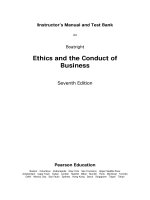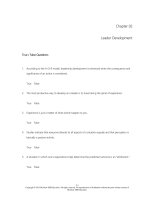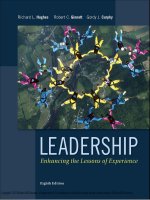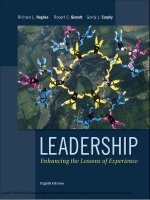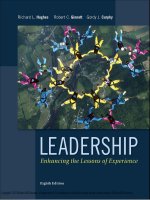Leadership enhancing the lessons of experience 7th edition hughes test bank
Bạn đang xem bản rút gọn của tài liệu. Xem và tải ngay bản đầy đủ của tài liệu tại đây (3.55 MB, 17 trang )
02
Student: ___________________________________________________________________________
1.
Leadership development through experience may be better understood as the growth resulting in terms of
an objective dimension like time.
True False
2.
The most productive way to develop as a leader is to travel along the spiral of experience.
True False
3.
Experience is just a matter of what events happen to you.
True False
4.
Perceptual set increases the selectivity in what people observe.
True False
5.
A situation in which one's expectations help determine the predicted outcome is an "attribution".
True False
6.
The tendency to overestimate the dispositional factors and underestimate environmental factors in
someone else's failure is fundamental attribution error.
True False
7.
Single-loop learning refers to a self-fulfilling belief system, which is generally not open to feedback.
True False
8.
Double-loop learning is the process of learning something that one already predicted, as in the "selffulfilling prophecy".
True False
9.
Role plays and videotape are used extensively during informal coaching sessions.
True False
10. The times when people most need to break out of the mold created by past learning patterns are the times
when they are most unwilling to do so.
True False
11. A drawback to action learning is that is requires time away from one's immediate job responsibilities.
True False
12. Leaders and followers use development plans as a road map for changing their own behaviors.
True False
13. Leadership practitioners have a tendency to concentrate on coaching their solid or top followers.
True False
14. Instruments providing 360-degree feedback to managers are particularly useful for leadership
development.
True False
15. Mentoring and coaching programs are essentially the same types of programs.
True False
16. The key to developing one's leadership ability is making the most of
A. experience.
B. research.
C. education.
D. skills.
17. Leadership development is enhanced when experience involves the three processes of
A. stopping, looking and listening.
B. perception, attribution and learning.
C. action, observation and reflection.
D. action, behavior and consequence.
18. _____ affect(s) all three phases of the action-observation-reflection model and thus plays a very
important role in what anyone will extract from a leadership course.
A. Emotions
B. Behavior
C. Personality
D. Perception
19. Which of the following statements concerning perceptual sets is false?
A. Perceptual sets can influence any of our senses.
B. Perceptual sets are the tendency to perceive everything.
C. Feelings can trigger a perceptual set.
D. They are the tendency to perceive one thing and not another.
20. In perception, the process of assigning underlying causes to behaviors is known as
A. attribution.
B. fundamental attribution error.
C. self-fulfilling prophecy.
D. single-loop learning.
21. Crediting your own successes to dispositional factors and others' successes to factors in the environment
are aspects of
A. attribution.
B. fundamental attribution error.
C. self-fulfilling prophecy.
D. double-loop learning.
22. The tendency to make external attributions for one's own failures, yet make internal attributions for one's
successes is called
A. fundamental attribution error.
B. actor/observer difference.
C. self-serving bias.
D. fallacy of the single cause.
23. People who are observing an action are much more likely than the actor to make the fundamental
attribution error. This is called
A. stereotyping.
B. fundamental attribution error.
C. ultimate attribution error.
D. actor/observer difference.
24. A situation in which one's expectations or predictions help determine the very results predicted is referred
to as
A. attribution.
B. fundamental attribution error.
C. self-fulfilling prophecy.
D. double-loop learning.
25. Which of the following statements concerning the reflection component of the AOR model is false?
A. Leaders are always aware of the value of reflection in leadership development.
B. It is the most neglected component of the AOR model.
C. It can provide leaders with a variety of insights into how to frame problems differently.
D. A reason for the reflection component to be neglected often may be due to time pressure at work.
26. What describes a kind of learning between the individual and the environment in which learners seek
relatively little feedback that may significantly confront their fundamental ideas or actions?
A. Deutero-learning
B. Double loop learning
C. Triple-loop learning
D. Single-loop learning
27. Confronting one's beliefs, inviting others to challenge you and working on personal blind spots are
aspects of the process of
A. attribution.
B. double-loop learning.
C. self-fulfilling prophecy.
D. single-loop learning.
28. Mastering _____ can be thought of as learning how to learn.
A. double-loop learning
B. single-loop learning
C. deutero-learning
D. triple-loop learning
29. The process by which an older and more experienced person helps to socialize and encourage younger
organizational colleagues is called
A. evaluating.
B. consulting.
C. mentoring.
D. networking.
30. Successful executives mention all of the following as negative feelings while describing how they feel
while working through potent developmental experiences except feeling
A. uncertain.
B. overwhelmed.
C. fearful.
D. challenged.
31. Which of the following statements is true regarding action learning?
A. Adults learn best by learning by doing, which is the basic philosophy of action learning.
B The level of demonstrated effectiveness of action learning programs for leadership development has not
. kept pace with their use for idea generation.
C. Action learning often involves assignment to a work team that addresses real time actual challenges the
company is facing.
D. All of these statements are true.
32. Leadership studies programs at the university-level
A. have historically been curricular-based programs offering academic credit in the form of academic
majors and minor.
B. appear to be rising in popularity in liberal-arts institutions.
C. are highly curricular based in liberal-arts institutions.
D. focus primarily on the one discipline of management science.
33. _____ consist of descriptions of various leadership situations and are used as a vehicle for leadership
discussions.
A. Simulations
B. Role playing
C. Case studies
D. Games
34. What is the advantage of role playing as a leadership concept?
A. Individualized feedback to students through leadership behavior ratings.
B. Depict the challenges commonly faced in the work environment.
C. Used as a vehicle for leadership discussions.
D. Greater transferability to the workplace.
35. Improving interpersonal, oral-communication and written-communication skills are a part of leadership
training programs for
A. mid-level managers.
B. first-level supervisors.
C. colleges or universities.
D. maintenance personnel.
36. Which of the following techniques that involve participants being given a limited amount of time to
prioritize and respond to a number of notes is particularly useful in assessing and improving a manager's
planning and time management skills?
A. Simulations
B. Role playing
C. In-basket exercises
D. Case studies
37. In leaderless group discussions, facilitators and observers rate participants, which are used to provide
managers with feedback about their
A. supervisory skills.
B. interpersonal skills.
C. planning skills.
D. time management skills.
38. Leadership programs for senior executives and CEOs tend to focus on
A. conceptual components.
B. individualized feedback.
C. intellectual components.
D. strategic planning.
39. In which step of informal coaching do leaders develop a coaching plan?
A. Shaping the environment
B. Growing skills
C. Inspire commitment
D. Promote persistence
40. In this step of informal coaching, leaders determine what drives their followers and where they want to go
with their careers.
A. Forging a partnership
B. Inspire commitment
C. Growing skills
D. Promote persistence
41. Informal coaching
A. begins with the manager's completion of an extensive battery of personality instruments.
B. is used to diagnose why behavioral change is not occurring and what can be done about it.
C. is more effective for high-performing followers than for low-performing followers.
D. is a one-on-one relationship between the manager and the coach.
42. In an organization, one can gain valuable perspectives and insights through close association with an
experienced person willing to take one under his/her wing. Such an individual is often called a
A. supervisor.
B. facilitator.
C. role model.
D. mentor.
43. Which of the following occurs when the organization assigns a relatively inexperienced but high-potential
leader to one of the top executives in the company?
A. Informal coaching
B. Informal mentoring
C. Formal coaching
D. Formal mentoring
44. Identify the main elements of the spiral of experience as discussed in this chapter.
45. Define single-loop learning.
46. Define double-loop learning.
47. What types of pedagogical elements are commonly used for leadership studies programs?
48. Explain how going against the grain is often an important ingredient in learning from experience.
49. Write a short discussion on the action-observation-reflection model.
50. Explain the role of perceptions in each aspect of the spiral of experience-observation, reflection and
action, with examples.
51. Explain your thoughts on how you would compare and contrast mentoring programs with coaching.
52. Write a short discussion on the five steps of informal coaching.
53. Explain how techniques such as role playing, in-basket exercises and leaderless group discussions
enhance leadership training.
02 Key
1.
(p. 44)
Leadership development through experience may be better understood as the growth resulting in terms
of an objective dimension like time.
FALSE
Difficulty: Moderate
Hughes - Chapter 02 #1
Type: Knowledge
2.
(p. 47)
The most productive way to develop as a leader is to travel along the spiral of experience.
TRUE
Difficulty: Easy
Hughes - Chapter 02 #2
Type: Knowledge
3.
(p. 47)
Experience is just a matter of what events happen to you.
FALSE
Difficulty: Easy
Hughes - Chapter 02 #3
Type: Knowledge
4.
(p. 49)
Perceptual set increases the selectivity in what people observe.
TRUE
Difficulty: Moderate
Hughes - Chapter 02 #4
Type: Knowledge
5.
(p. 51)
A situation in which one's expectations help determine the predicted outcome is an "attribution".
FALSE
Difficulty: Moderate
Hughes - Chapter 02 #5
Type: Knowledge
6.
(p. 51)
The tendency to overestimate the dispositional factors and underestimate environmental factors in
someone else's failure is fundamental attribution error.
TRUE
Difficulty: Moderate
Hughes - Chapter 02 #6
Type: Knowledge
7.
(p. 55)
Single-loop learning refers to a self-fulfilling belief system, which is generally not open to
feedback.
TRUE
Difficulty: Easy
Hughes - Chapter 02 #7
Type: Knowledge
8.
(p. 56)
Double-loop learning is the process of learning something that one already predicted, as in the "selffulfilling prophecy".
FALSE
Difficulty: Easy
Hughes - Chapter 02 #8
Type: Knowledge
9.
(p. 74)
Role plays and videotape are used extensively during informal coaching sessions.
FALSE
Difficulty: Moderate
Hughes - Chapter 02 #9
Type: Knowledge
10.
(p. 58)
The times when people most need to break out of the mold created by past learning patterns are the
times when they are most unwilling to do so.
TRUE
Difficulty: Easy
Hughes - Chapter 02 #10
Type: Knowledge
11.
(p. 66)
A drawback to action learning is that is requires time away from one's immediate job
responsibilities.
FALSE
Difficulty: Easy
Hughes - Chapter 02 #11
Type: Knowledge
12.
(p. 69)
Leaders and followers use development plans as a road map for changing their own behaviors.
TRUE
Difficulty: Moderate
Hughes - Chapter 02 #12
Type: Knowledge
13.
(p. 72)
Leadership practitioners have a tendency to concentrate on coaching their solid or top followers.
FALSE
Difficulty: Moderate
Hughes - Chapter 02 #13
Type: Knowledge
14.
(p. 74)
Instruments providing 360-degree feedback to managers are particularly useful for leadership
development.
TRUE
Difficulty: Easy
Hughes - Chapter 02 #14
Type: Knowledge
15.
(p. 76)
Mentoring and coaching programs are essentially the same types of programs.
FALSE
Difficulty: Easy
Hughes - Chapter 02 #15
Type: Knowledge
16.
(p. 46-47)
The key to developing one's leadership ability is making the most of
A. experience.
B. research.
C. education.
D. skills.
Difficulty: Moderate
Hughes - Chapter 02 #16
Type: Knowledge
17.
(p. 47)
Leadership development is enhanced when experience involves the three processes of
A. stopping, looking and listening.
B. perception, attribution and learning.
C. action, observation and reflection.
D. action, behavior and consequence.
Difficulty: Easy
Hughes - Chapter 02 #17
Type: Knowledge
18.
(p. 49)
_____ affect(s) all three phases of the action-observation-reflection model and thus plays a very
important role in what anyone will extract from a leadership course.
A. Emotions
B. Behavior
C. Personality
D. Perception
Difficulty: Moderate
Hughes - Chapter 02 #18
Type: Knowledge
19.
(p. 49-50)
Which of the following statements concerning perceptual sets is false?
A. Perceptual sets can influence any of our senses.
B. Perceptual sets are the tendency to perceive everything.
C. Feelings can trigger a perceptual set.
D. They are the tendency to perceive one thing and not another.
Difficulty: Moderate
Hughes - Chapter 02 #19
Type: Knowledge
20.
(p. 51)
In perception, the process of assigning underlying causes to behaviors is known as
A. attribution.
B. fundamental attribution error.
C. self-fulfilling prophecy.
D. single-loop learning.
Difficulty: Easy
Hughes - Chapter 02 #20
Type: Knowledge
21.
(p. 51)
Crediting your own successes to dispositional factors and others' successes to factors in the
environment are aspects of
A. attribution.
B. fundamental attribution error.
C. self-fulfilling prophecy.
D. double-loop learning.
Difficulty: Moderate
Hughes - Chapter 02 #21
Type: Vocabulary
22.
(p. 51)
The tendency to make external attributions for one's own failures, yet make internal attributions for
one's successes is called
A. fundamental attribution error.
B. actor/observer difference.
C. self-serving bias.
D. fallacy of the single cause.
Difficulty: Moderate
Hughes - Chapter 02 #22
Type: Vocabulary
23.
(p. 51)
People who are observing an action are much more likely than the actor to make the fundamental
attribution error. This is called
A. stereotyping.
B. fundamental attribution error.
C. ultimate attribution error.
D. actor/observer difference.
Difficulty: Easy
Hughes - Chapter 02 #23
Type: Knowledge
24.
(p. 53)
A situation in which one's expectations or predictions help determine the very results predicted is
referred to as
A. attribution.
B. fundamental attribution error.
C. self-fulfilling prophecy.
D. double-loop learning.
Difficulty: Easy
Hughes - Chapter 02 #24
Type: Knowledge
25.
Which of the following statements concerning the reflection component of the AOR model is false?
(p. 54)
A.
B.
C.
D.
Leaders are always aware of the value of reflection in leadership development.
It is the most neglected component of the AOR model.
It can provide leaders with a variety of insights into how to frame problems differently.
A reason for the reflection component to be neglected often may be due to time pressure at work.
Difficulty: Hard
Hughes - Chapter 02 #25
Type: Knowledge
26.
(p. 55)
What describes a kind of learning between the individual and the environment in which learners seek
relatively little feedback that may significantly confront their fundamental ideas or actions?
A. Deutero-learning
B. Double loop learning
C. Triple-loop learning
D. Single-loop learning
Difficulty: Moderate
Hughes - Chapter 02 #26
Type: Knowledge
27.
(p. 56)
Confronting one's beliefs, inviting others to challenge you and working on personal blind spots are
aspects of the process of
A. attribution.
B. double-loop learning.
C. self-fulfilling prophecy.
D. single-loop learning.
Difficulty: Easy
Hughes - Chapter 02 #27
Type: Vocabulary
28.
(p. 56)
Mastering _____ can be thought of as learning how to learn.
A. double-loop learning
B. single-loop learning
C. deutero-learning
D. triple-loop learning
Difficulty: Moderate
Hughes - Chapter 02 #28
Type: Knowledge
29.
(p. 76)
The process by which an older and more experienced person helps to socialize and encourage younger
organizational colleagues is called
A. evaluating.
B. consulting.
C. mentoring.
D. networking.
Difficulty: Easy
Hughes - Chapter 02 #29
Type: Knowledge
30.
(p. 58)
Successful executives mention all of the following as negative feelings while describing how they feel
while working through potent developmental experiences except feeling
A. uncertain.
B. overwhelmed.
C. fearful.
D. challenged.
Difficulty: Easy
Hughes - Chapter 02 #30
Type: Knowledge
31.
(p. 64-66)
Which of the following statements is true regarding action learning?
A. Adults learn best by learning by doing, which is the basic philosophy of action learning.
B The level of demonstrated effectiveness of action learning programs for leadership development has
. not kept pace with their use for idea generation.
C. Action learning often involves assignment to a work team that addresses real time actual challenges
the company is facing.
D. All of these statements are true.
Difficulty: Hard
Hughes - Chapter 02 #31
Type: Knowledge
32.
(p. 59)
Leadership studies programs at the university-level
A. have historically been curricular-based programs offering academic credit in the form of academic
majors and minor.
B. appear to be rising in popularity in liberal-arts institutions.
C. are highly curricular based in liberal-arts institutions.
D. focus primarily on the one discipline of management science.
Difficulty: Moderate
Hughes - Chapter 02 #32
Type: Knowledge
33.
(p. 62)
_____ consist of descriptions of various leadership situations and are used as a vehicle for leadership
discussions.
A. Simulations
B. Role playing
C. Case studies
D. Games
Difficulty: Easy
Hughes - Chapter 02 #33
Type: Vocabulary
34.
(p. 62)
What is the advantage of role playing as a leadership concept?
A. Individualized feedback to students through leadership behavior ratings.
B. Depict the challenges commonly faced in the work environment.
C. Used as a vehicle for leadership discussions.
D. Greater transferability to the workplace.
Difficulty: Hard
Hughes - Chapter 02 #34
Type: Knowledge
35.
(p. 63)
Improving interpersonal, oral-communication and written-communication skills are a part of
leadership training programs for
A. mid-level managers.
B. first-level supervisors.
C. colleges or universities.
D. maintenance personnel.
Difficulty: Moderate
Hughes - Chapter 02 #35
Type: Knowledge
36.
(p. 63)
Which of the following techniques that involve participants being given a limited amount of time
to prioritize and respond to a number of notes is particularly useful in assessing and improving a
manager's planning and time management skills?
A. Simulations
B. Role playing
C. In-basket exercises
D. Case studies
Difficulty: Easy
Hughes - Chapter 02 #36
Type: Knowledge
37.
(p. 64)
In leaderless group discussions, facilitators and observers rate participants, which are used to provide
managers with feedback about their
A. supervisory skills.
B. interpersonal skills.
C. planning skills.
D. time management skills.
Difficulty: Moderate
Hughes - Chapter 02 #37
Type: Knowledge
38.
(p. 64)
Leadership programs for senior executives and CEOs tend to focus on
A. conceptual components.
B. individualized feedback.
C. intellectual components.
D. strategic planning.
Difficulty: Moderate
Hughes - Chapter 02 #38
Type: Vocabulary
39.
(p. 71)
In which step of informal coaching do leaders develop a coaching plan?
A. Shaping the environment
B. Growing skills
C. Inspire commitment
D. Promote persistence
Difficulty: Hard
Hughes - Chapter 02 #39
Type: Knowledge
40.
(p. 70)
In this step of informal coaching, leaders determine what drives their followers and where they want
to go with their careers.
A. Forging a partnership
B. Inspire commitment
C. Growing skills
D. Promote persistence
Difficulty: Hard
Hughes - Chapter 02 #40
Type: Knowledge
41.
(p. 72)
Informal coaching
A. begins with the manager's completion of an extensive battery of personality instruments.
B. is used to diagnose why behavioral change is not occurring and what can be done about it.
C. is more effective for high-performing followers than for low-performing followers.
D. is a one-on-one relationship between the manager and the coach.
Difficulty: Hard
Hughes - Chapter 02 #41
Type: Knowledge
42.
(p. 75-76)
In an organization, one can gain valuable perspectives and insights through close association with an
experienced person willing to take one under his/her wing. Such an individual is often called a
A. supervisor.
B. facilitator.
C. role model.
D. mentor.
Difficulty: Easy
Hughes - Chapter 02 #42
Type: Knowledge
43.
(p. 76)
Which of the following occurs when the organization assigns a relatively inexperienced but highpotential leader to one of the top executives in the company?
A. Informal coaching
B. Informal mentoring
C. Formal coaching
D. Formal mentoring
Difficulty: Moderate
Hughes - Chapter 02 #43
Type: Knowledge
44.
Identify the main elements of the spiral of experience as discussed in this chapter.
(p. 47)
The spiral of experience is composed of three main elements: Action (what did you do?), observation
(what happened?) and reflection (how do you look at it now?).
Difficulty: Moderate
Hughes - Chapter 02 #44
Type: Knowledge
45.
Define single-loop learning.
(p. 55)
Single-loop learning exists when learners seek relatively little feedback that significantly confronts
their fundamental ideas or actions. There is relatively little public testing of ideas against valid
information.
Difficulty: Hard
Hughes - Chapter 02 #45
Type: Knowledge
46.
Define double-loop learning.
(p. 56)
Double-loop learning involves a willingness to confront one's own views and an invitation to others
to do so, too. It is associated with a view that openness to information and power sharing with others
can lead to better recognition and definition of problems, improved communication and increased
decision-making effectiveness.
Difficulty: Moderate
Hughes - Chapter 02 #46
Type: Knowledge
47.
What types of pedagogical elements are commonly used for leadership studies programs?
(p. 62)
The pedagogy used to impart different leadership concepts to students can vary greatly. These may
include individualized feedback, case studies, role playing, simulations and games. More recently,
participants in development programs are placed in unfamiliar situations and presented with physical,
emotionally arousing, and often team-oriented challenges.
Difficulty: Moderate
Hughes - Chapter 02 #47
Type: Knowledge
48.
Explain how going against the grain is often an important ingredient in learning from experience.
(p. 58)
Bunker and Webb note that executives try to be successful without experiencing stress. Due to
organizational pressures to perform, they are often most comfortable drawing from a proven repertoire
of operating skills to tackle a challenge they have conquered in the past. The result is a paradox. When
people need to change course from their past learning patterns is when they are most unwilling to
do so. Being able to go against the grain of one's personal historical success requires an unwavering
commitment to learning and a relentless willingness to let go of the fear of failure and the unknown.
If one is not willing to go against the grain and tolerate a small dip in performance, then there is no
learning.
Difficulty: Hard
Hughes - Chapter 02 #48
Type: Knowledge
49.
Write a short discussion on the action-observation-reflection model.
(p. 47-49)
According to the action-observation-reflection model, leadership development is enhanced when the
experience involves three different processes: action, observation and reflection. If a person acts but
does not observe the consequences of her actions or reflect on their significance and meaning, then
it makes little sense to say she has learned from an experience. Because some people neither observe
the consequences of their actions nor reflect on how they could change their actions to become better
leaders, leadership development through experience may be better understood as the growth resulting
from repeated movements through all three phases rather than merely in terms of some objective
dimension like time The most productive way to develop as a leader is to travel along the spiral of
experience.
Difficulty: Moderate
Hughes - Chapter 02 #49
Type: Knowledge
50.
(p. 49-53)
Explain the role of perceptions in each aspect of the spiral of experience-observation, reflection and
action, with examples.
Perception is critical to the spiral of experience since experience is not just a matter of what happens
to you; it also depends on how you perceive those events.
With regard to observation, we do not perceive everything in our environment. We are selective in
what we attend to and, in turn, what we perceive. For example, it is a common misconception that the
eye operates essentially like the film in a continuously running camera. The fallacy of this passive
view of perception is that it assumes we attend to all aspects of a situation equally.
Perception plays a part in the reflection stage, since reflection deals with how we interpret what we
observe. Perception is inherently an interpretive activity. One important aspect of this deals with
a process called attribution. For example, if you see Julie fail in an attempt to get others to form a
study group, you are likely to attribute the cause of the failure to dispositional factors within Julie.
Reflection also involves higher functions like evaluation and judgment, not just perception and
attribution.
Perception also affects the actions we take. For example, researchers have examined how perceptions
and biases affect supervisors' actions in response to poorly performing subordinates. In general, these
researchers found that supervisors were biased toward making dispositional attributions about a
subordinate's substandard performance and, as a result of these attributions, often recommended that
punishment be used to remedy the performance deficit.
Difficulty: Hard
Hughes - Chapter 02 #50
Type: Knowledge
51.
(p. 76)
Explain your thoughts on how you would compare and contrast mentoring programs with
coaching.
Mentoring is a personal relationship in which a more experienced mentor (usually someone two to
four levels higher in an organization) acts as a guide, role model, and sponsor of a less experienced
protégé. Mentors provide protégés with knowledge, advice, challenge, counsel, and support about
career opportunities, organizational strategy and policy, office politics, and other such issues.
Although mentoring has a strong developmental component, it is not the same as coaching. One key
difference is that mentoring may not target specific development needs. Protégés often meet with their
mentors to get a different perspective of the organization or for advice on potential committee and task
force assignments or promotion opportunities. Another difference is that this guidance is not coming
from the protégé's immediate supervisor, but rather from someone several leadership levels higher in
the organization. Protégés often do receive informal coaching from their boss, but may be more apt
to seek career guidance and personal advice from their mentors. Another difference is that the mentor
may not even be part of the organization. Some mentors may have retired from the organization, or
may have been someone for whom the protégé worked a number of years earlier.
Difficulty: Hard
Hughes - Chapter 02 #51
Type: Knowledge
52.
Write a short discussion on the five steps of informal coaching.
(p. 79)
Informal coaching takes place whenever a leader helps followers to change their behaviors. The best
informal coaching generally consists of five steps. In forging a partnership, leaders build a trusting
relationship with their followers, identify followers' career goals and motivators and learn how their
followers view the organization and their situation. Leaders then need to inspire commitment. In
this step, leaders work closely with followers to gather and analyze data to determine development
needs. The next step in the coaching process involves growing skills. Followers use their prioritized
development needs to create a development plan and leaders in turn develop a coaching plan that
spells out precisely what they will do to support the followers' development plan. Leaders and
followers then review and discuss the development and coaching plans, make necessary adjustments
and execute the plans.
In the step called promote persistence, leaders help followers to manage the mundane, day-to-day
aspects of development. Leaders can help followers refocus on their development by capitalizing
on opportunities to give followers relevant, on-the-spot feedback. Once the new behavior has been
practiced a number of times and becomes part of the follower's behavioral repertoire, then leaders help
followers to transfer the skills to new environments by applying the skills in new settings and revising
their development plans.
Difficulty: Hard
Hughes - Chapter 02 #52
Type: Knowledge
53.
(p. 62-63)
Explain how techniques such as role playing, in-basket exercises and leaderless group discussions
enhance leadership training.
In role playing, learners are assigned parts to play (e.g., a supervisor and an unmotivated subordinate)
in a job-related scenario. Role playing has the advantage of letting trainees actually practice relevant
skills and thus has greater transferability to the workplace than didactic instructional methods like
lectures.
In-basket exercises involve participants having a limited amount of time to prioritize and respond to a
number of notes, letters and phone messages from a fictitious manager's in-basket. This technique is
useful in assessing and improving a manager's planning and time management skills.
In leaderless group discussions, facilitators and observers rate participants on the degree of
persuasiveness, leadership, followership or conflict each member manifests in a group that has no
appointed leader. These ratings are used to provide managers with feedback about their interpersonal
and oral-communication skills.
Difficulty: Moderate
Hughes - Chapter 02 #53
Type: Knowledge
02 Summary
Category
Difficulty: Easy
Difficulty: Hard
Difficulty: Moderate
Hughes - Chapter 02
Type: Knowledge
Type: Vocabulary
# of Questions
18
11
24
53
48
5
